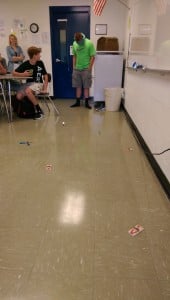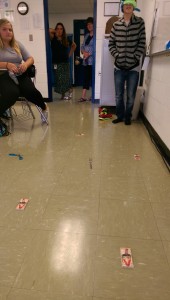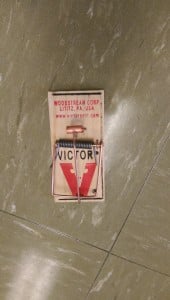
 I saw this life changing lesson performed during a church service about three years ago and I have used it in the classroom ever since. I call it a life changing lesson, titled after Dave Burgess’ LCL’s he uses in his classroom (Teach Like A Pirate). I recommend setting the stage with some of Dave’s hooks, like the taboo hook or a mystery box hook. Both of these will add to this amazing experience. I’ve done this for years on days 2 or 3 with my classes. I still don’t know all their names, but they leave with a memorable experience. The experience begins by blindfolding a volunteer at the front of the classroom. It’s necessary that the volunteer take his/her shoes off as it helps increase the suspense or thrill. Obviously, you need enough clear space to establish a point A and point B for the volunteer to travel. Once blindfolded, the teacher will grab his/her bag and begin to pull out mouse traps, knives, forks, scissors (anything that will elicit some gasps from audience). Strategically place the mouse traps and other obstacles out front of the volunteer, creating a maze-like pattern of dangerous obstacles. I do this slowly, while instructing the volunteer to stand very still. I even let a mouse trap or two snap loudly to help build the intensity. Often the volunteer will nervously ask “what was that Mr. Oldfield?” I typically respond “Oh that was nothing. You trust me right?” Anything you can do to help increase the intensity here will help hook the audience and the volunteer. Once the path is set, I explain that the audience will have opportunity to direct the volunteer down the path, but they’ll have to be careful and very specific in their directions. What usually plays out next is a combination of the audience calling out directions, some good and some bad, while I stand next to the volunteer confirming some orders and monitoring his/her safety. Once the volunteer has surpassed one or two obstacles, I will step on one of the mouse traps, setting it off loudly. This normally ignites some anxiety in the volunteer. I kick the trap out of the way and the volunteer continues. Once the volunteer has completed the journey, he/she is allowed to remove the blindfold and look back at the obstacles.
I saw this life changing lesson performed during a church service about three years ago and I have used it in the classroom ever since. I call it a life changing lesson, titled after Dave Burgess’ LCL’s he uses in his classroom (Teach Like A Pirate). I recommend setting the stage with some of Dave’s hooks, like the taboo hook or a mystery box hook. Both of these will add to this amazing experience. I’ve done this for years on days 2 or 3 with my classes. I still don’t know all their names, but they leave with a memorable experience. The experience begins by blindfolding a volunteer at the front of the classroom. It’s necessary that the volunteer take his/her shoes off as it helps increase the suspense or thrill. Obviously, you need enough clear space to establish a point A and point B for the volunteer to travel. Once blindfolded, the teacher will grab his/her bag and begin to pull out mouse traps, knives, forks, scissors (anything that will elicit some gasps from audience). Strategically place the mouse traps and other obstacles out front of the volunteer, creating a maze-like pattern of dangerous obstacles. I do this slowly, while instructing the volunteer to stand very still. I even let a mouse trap or two snap loudly to help build the intensity. Often the volunteer will nervously ask “what was that Mr. Oldfield?” I typically respond “Oh that was nothing. You trust me right?” Anything you can do to help increase the intensity here will help hook the audience and the volunteer. Once the path is set, I explain that the audience will have opportunity to direct the volunteer down the path, but they’ll have to be careful and very specific in their directions. What usually plays out next is a combination of the audience calling out directions, some good and some bad, while I stand next to the volunteer confirming some orders and monitoring his/her safety. Once the volunteer has surpassed one or two obstacles, I will step on one of the mouse traps, setting it off loudly. This normally ignites some anxiety in the volunteer. I kick the trap out of the way and the volunteer continues. Once the volunteer has completed the journey, he/she is allowed to remove the blindfold and look back at the obstacles.
The next portion of the lesson is where the teacher facilitates the valuable learning experience. My discussion begins by acknowledging that this experience that took place actually represented something larger. I like to give my students some time to discuss at their tables some ideas they may have about what they think the entire experience represented. Next I usually reveal the three key players in the experience: the mouse traps, me, and the crowd. I allow my students some time to discuss the three roles and who each of them represented. During the discussion at the tables, I make my rounds listening and guiding the discussions in the right directions. The easiest connection to make seems to be that the mouse traps represented danger or obstacles that lie in our paths. So that’s a good place to start with your students. You can carry the rest of the discussion out however you best see fit. But I think it’s important to emphasize the distinction between the teacher and the crowd, and who those two parties represent. In my opinion, the teacher represented the following groups of people that you may want your students to recognize: parents, teachers, coaches, pastors. The crowd represented the following groups of people: classmates, friends, teammates. While developing this distinction, I always try to remind my students which person kicked one or two of the obstacles out of the way for the volunteer. I (teacher) kicked an obstacle out of the way because I was close to the volunteer. It’s all about distance, literal and figurative. Typically classmates, friends, teammates have an impact on us, but they can’t really remove obstacles from our path. Their impact is never that direct. But parents, teachers, and coaches sometimes have an impact that can be that direct. Moral of the story is that during my students’ years (14-17 years of age), they often tend to distance themselves from those who have the most impact on their journey. The class always agrees that the volunteer never would have made it through the path without any guidance. It’s often the case that they never would have made it exclusively on the guidance of the crowd, because it was sometimes hard to distinguish between good advice and bad advice when listening only to the crowd. The noise level also made it hard to hear the right voices. Bottom line, it’s nice to be reminded at 14-17 years of age, that as much as we sometimes think we don’t need them, we really do need those people who offer to walk life’s journey right by our side.


Wow, that is a very creative way to teach a life changing lesson, and it seems that your classmates really learn from it.